|
Week 9: September 26 - October 2, 2012 |
Welcome
to the McGill Bird Observatory weekly report.
Click here for a complete listing of our archives.
Comments or
questions are welcome at "mbo AT migrationresearch.org".
|
PICTURE
OF THE WEEK: |
|
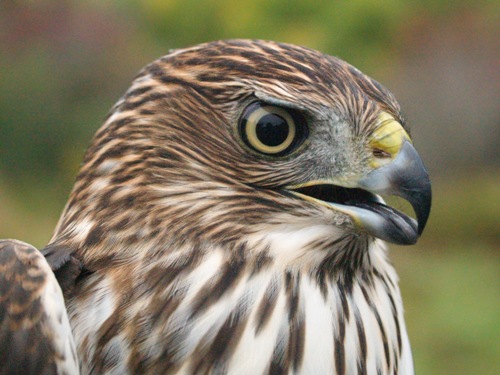
Week 9 began impressively with this female Cooper's Hawk, just the third of
its kind banded at MBO.
(Photo by Simon Duval)
-
|
|
|
THIS WEEK |
THIS FALL |
2012 TOTAL |
SITE TOTAL |
|
# birds (and species) banded |
447 (42) |
2414 (78) |
3679 (86) |
39430 (108) |
|
# birds (and species) repeat |
118 (23) |
648 (43) |
986 (54) |
7399 (70) |
|
# birds (and species) return |
6 (3) |
66 (20) |
205 (27) |
1166 (38) |
|
# species observed |
90 |
138 |
164 |
207 |
|
# net hours |
552.0 |
4873.8 |
8133.6 |
67232.7 |
|
# birds banded / 100 net hours |
80.1 |
49.5 |
45.2 |
58.6 |
|
|
Note: table does not include nocturnal banding (owls) |
|
Banders-in-charge: Bob Barnhurst, Simon Duval, Marcel Gahbauer, Gay Gruner
Assistants: Nicolas Bernier, Cindy Bouchard, Chantal Cloutier, Yolande Cossette, David Davey, Rui de Jesus, Leah den Besten, Steve Dumont, Réjean Duval, Tammy Elliot, Nicki Fleming, Liette Fortier, Alexandre Fouillet, Barbara Frei, Andray Gagné, Louise Gagné, Jo-Annie Gagnon, Alison Hackney, Myriam Haineault, Nathaniel Harper, James Junda, Lisa Keelty, Shelley Kirk, Patrick Laniel, Barbara MacDuff, Betsy McFarlane, Ana Morales, Geneviève Potvin, Catherine Russell, Marilou Skelling, Alex Stone, Rodger and Elise Titman, Jessica Turgeon
Notes: Activity throughout most of week 9 was fairly modest for this time of fall, but it picked up momentum toward the end. Overall, the number of birds banded this week was lower than in any previous "even year" (i.e. 2006, 2008, 2010), but above the total in all "odd years" (2005, 2007, 2009, 2011), which have consistently ranged between 311 and 380. This was largely due to the 152 birds banded on the final day of the week, nearly double this fall's previous high of 86, on September 14. However, diversity was high throughout the week, with more than 20 species banded on three days (unusual this late in the season), and also a daily estimated total of between 46 and 58 species on site, well above average for late September / early October. As has been the case throughout this fall, repeats were numerous this week, with at least 10 per day, very similar to the pace in 2010, when we had 633 by this point. While a large number of stopovers is not surprising during migration, it's more unexpected to still be getting many returns after two months of daily banding; most of these are likely local breeders or year-round residents, but may have been a bit less active during their moulting period.

These two Orange-crowned Warblers provide an interesting contrast, and fodder for debate. Are they simply two extremes of plumage of the eastern celata subspecies, or is the one on the left an orestera subspecies from western Canada?
(Photo by
Simon Duval)
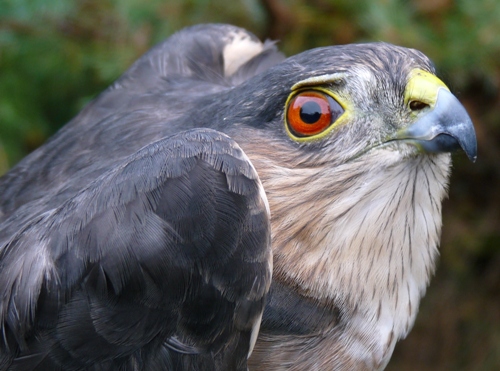
Although Sharp-shinned Hawks are banded at MBO far more often than any other raptor, the vast majority of them are hatch-year birds, so this after-second-year female with prominent reddish eyes was a rare treat to see up close.
(Photo by
Marcel Gahbauer)
|
New for the year this week was BIcknell's Thrush, bringing the MBO species list to 164 species for 2012. Other new fall sightings were Common Merganser, Greater Yellowlegs, Rough-legged Hawk, and Eastern Bluebird, with the cumulative total of 138 just ahead of the past two years at this point in fall (135 in 2010, 136 in 2011). The Bicknell's Thrush and Cooper's Hawk were banded for the first time this year, while Orange-crowned Warbler and Rusty Blackbird were firsts for this fall. Among our many repeats this week were six species we documented as stopovers for the first time this year (Northern Saw-whet Owl, Blue-headed Vireo, Wood Thrush, Gray-cheeked Thrush, Northern Parula, and Yellow-rumped Warbler), as well as another two for the first time this fall (White-crowned Sparrow and Slate-colored Junco). The Wood Thrush was the first we have ever documented as a repeat at MBO, so we have now at least once recaptured 70 of the 108 species banded to date. This week also marked the first time we captured a previously banded Northern Saw-whet Owl during our main Fall Migration Monitoring Program, although we of course previously recaptured them as part of our owling program at night..
This week’s top 10 [last week's rank in brackets]
# individuals banded |
mean # individuals observed daily |
1. White-throated Sparrow (112) [1] |
1. Canada Goose (407) [1] |
2. Yellow-rumped Warbler (84) [-] |
2. Red-winged Blackbird (278) [4] |
3. Ruby-crowned Kinglet (67) [4] |
3. European Starling (222) [-] |
4. Swainson's Thrush (21) [3] |
4. Common Grackle (110) [-] |
5. Song Sparrow (19) [6] |
5. White-throated Sparrow (104) [3] |
6. Golden-crowned Kinglet (14) [10] |
6. American Robin (93) [5] |
7. Nashville Warbler (11) [7] |
7. Blue Jay (65) [2] |
8. Black-capped Chickadee (10) [9] |
8. Yellow-rumped Warbler (48) [-] |
9. Blue Jay (9) [2] |
9. American Crow (38) [6] |
10. White-crowned Sparrow (9) [-]
|
10. Black-capped Chickadee (28) [7] |
|
In every previous "even" year of the Fall Migration Monitoring Program (i.e. 2006, 2008, 2010), the top three species banded in week 9 have been Yellow-rumped Warbler, followed by Ruby-crowned Kinglet, then White-throated Sparrow. This year, things shifted just a bit, with White-throated Sparrow surging up to the top spot, thanks to their strongest ever week 9 migration in terms of individuals banded, with 112 this week. A fair bit behind week 9's traditional top trio was Swainson's Thrush, continuing to move through in impressive numbers, with the season total now up to 156 banded. Song Sparrows increased further this week, perhaps representing a wave of more northern migrants coming through, with the season total boosted to 179, and a good number more likely yet to come. Golden-crowned Kinglets were somewhat more numerous than usual this week, while we had a fairly typical movement of Nashville Warblers; both species are often in the lower half of the top ten by this point in fall. We continue to hear reports of substantial chickadee migration further north; with another 10 this week, the season total is already up to 61 - well above average for most years, and with the peak migration period (based on our 2010 experience) yet to come. Blue Jays dropped from second place last week to ninth this week, but with another 9 birds banded, the season total of 45 is a new fall record. Rounding out the top ten this week is White-crowned Sparrow, with a roughly average number for this time of year. Dropping out of the top ten for the first time since week 2 was Magnolia Warbler, as well as last week's surprise entries, Gray-cheeked Thrush and Brown Creeper.
Canada Goose has been the most abundant species observed in week 9 every year, and 2012 proved to be no exception, although both Red-winged Blackbird and European Starling mounted good challenges to round out the top three, with each species being recorded in numbers of 500+ at least once this week (and 100+ on several other days). Common Grackles also came back to the site in big numbers this week, adding to the rich blackbird mix in the skies. For only the second time ever, we had five species with an average of more than 100 individuals observed per day. The first time was Week 10 of fall 2010, with Canada Goose, Yellow-rumped Warbler, Red-winged Blackbird, American Crow, and American Robin. This week, it was White-throated Sparrow that rounded out the 100+ club, with American Robin not far behind. Blue Jays dropped to seventh place this week after being the runner-up last week, even though the mean daily count of 65 was only slightly lower than last week's 75. American Crow and Black-capped Chickadee slipped down the list even though their numbers increased over last week; Yellow-rumped Warbler was the only other new addition, with nearly 50 per day on average. The bottom three species from last week's list (American Goldfinch, Cedar Waxwing, and Ring-billed Gull) were displaced by this week's increases by other species.
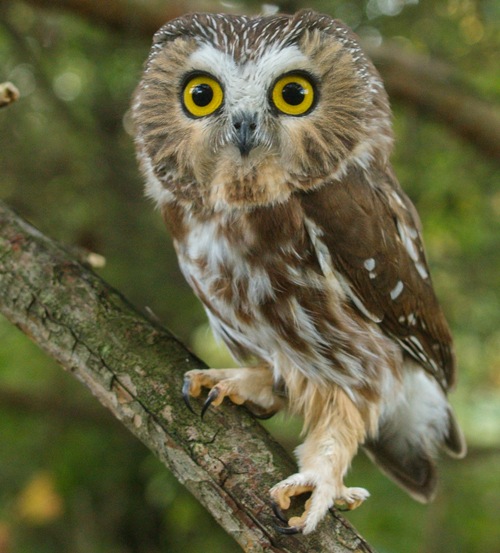
The Saw-whet Owl Monitoring Program is up and running again - but this one decided to be part of our overall Fall Migration Monitoring Program instead, showing up in the first net round of the morning on Thursday.
(Photo by
Simon Duval) |
For the third year in a row, we are operating a full six-week Saw-whet Owl Monitoring Program, running nightly (weather permitting) from September 26 through November 6. The season got off to a tremendous start with 14 Northern Saw-whet Owls (plus 2 Eastern Screech-Owls) on the first night, and another 15 saw-whets on the second. The pace slowed down after that, with 6 more (plus another screech) on the third night, and a shut-out on the fourth, before a night off due to rain, and then two more evenings with 3 each, for a total of 41 saw-whets in the opening week. Considering that in the past, we had operated the owl program on 12 nights in September over a five-year period, with a grand total of 7 individuals banded, this week's results are remarkable. Other research stations to the north of us, in both Ontario and Quebec, have also been reporting a large early movement of saw-whets, so our tally is consistent, though still surprising. We are very curious whether the migration is simply earlier than usual this year, or particularly large.
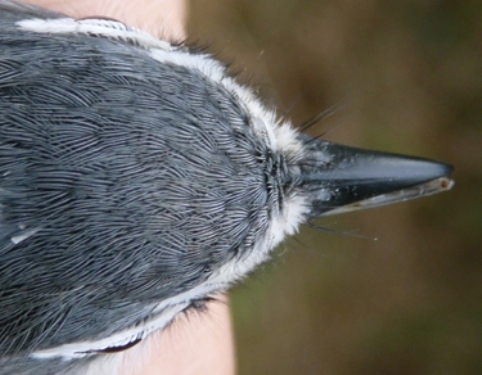
Nearly one year ago (week 10) we banded a cross-billed Blue-headed Vireo; this week we had one with the upper mandible slightly offset from the lower, and with the hooked tip not overhanging the tip as usual. Less of a concern for the bird, but just as unusual, was the "Orange-crowned Kinglet" below ... a male Ruby-crowned Kinglet with all of its central crown feathers distinctly orange instead of red.
(Photos by
Marcel Gahbauer)
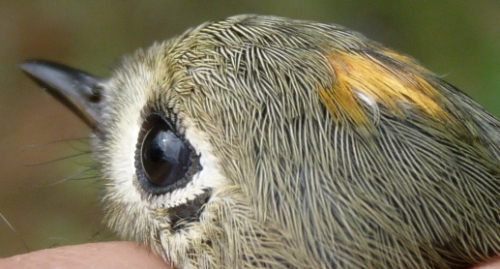
|
The last day of week 9 was by far our busiest day of fall 2012 to date, giving us hope that we are on the verge of the peak of migration. The next week could be full of many more Yellow-rumped Warblers, White-throated Sparrows, and Ruby-crowned Kinglets ... or not, of course. The answer to that will be in next week's report!
|
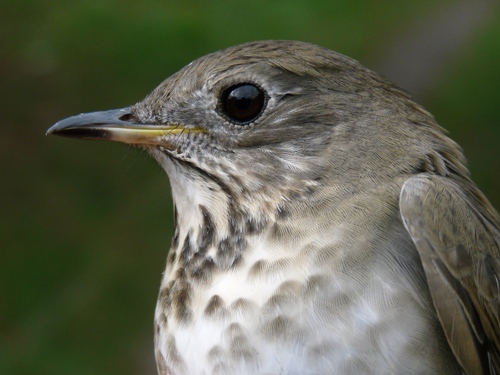
Remarkably, after banding only three Bicknell's Thrushes over our first seven years, we had two this week, including the one above.
(Photo by Marcel Gahbauer)
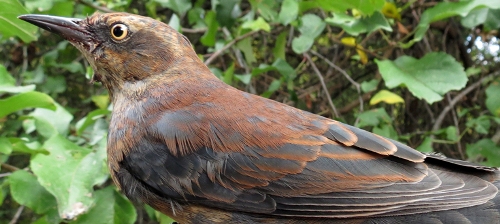
The Bicknell's Thrush (listed under the Species at Risk Act as Threatened) wasn't the only species at risk banded this week - we also had this Rusty Blackbird, classified as Special Concern.
(Photo by
Gay Gruner)
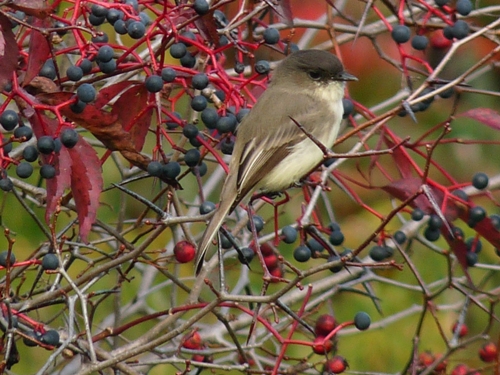
Not as rare with respec to status, but also getting distinctly uncommon by this point in fall are all the flycatchers, with an occasional Eastern Phoebe such as this the only species we are likely to encounter - in this case finding a perch among one of our hawthorns, liberally decorated with Virginia Creeper.
(Photo by
Marcel Gahbauer)
|









